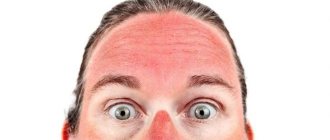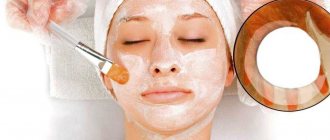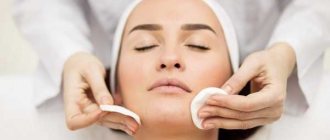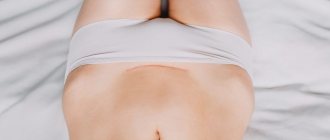Facial cleansing is one of the most popular cosmetic procedures. It allows you to tone your skin, remove dead cells, and get rid of clogged pores, blackheads and acne. But even with the most gentle technique, the face is subjected to intense exposure - the skin becomes sensitive and cannot fully protect itself from external factors. To recover faster after the procedure and avoid complications, you need to provide proper home care after facial cleansing.
Medium skin peeling
Medium peels are used for skin rejuvenation, because... actively stimulate the production of collagen in the dermis, as well as to combat hyperpigmentation.
Among the most popular: Jessner peel and its modifications, TCA (trichloroacetic peels), retinol/retinoic (also called “yellow peel”).
Medium peeling affects the entire stratum corneum and part of the epidermis. The most likely post-peeling consequences : the occurrence of erythema, the skin will peel, and during the procedure the occurrence of unpleasant sensations in the form of a burning sensation, sometimes accompanied by swelling. All this is normal , and usually the degree of manifestation depends on the number of layers that are applied during the procedure and how deeply the skin is affected!
Sometimes the post-peeling period is accompanied by pustular rashes, which indicates improper preparation of the skin.
Medium peeling is excluded for skin with hypersensitivity.
Healing takes 7 days, during which noticeable peeling, redness and some swelling of the skin are noted. This type of peeling procedure requires the strictest adherence to post-peel care instructions:
Cleanser
If skin barriers are damaged, the cleanser should not foam and contain aggressive surfactants. Only special preparations for delicate and sensitive skin are recommended, in the form of milk, with an oil base.
Example : DermaQuest Cleansing Milk for Delicate Skin is a cleansing milk based on valuable Shea and Jojoba oils with a cream texture. Removes all impurities while restoring damaged barriers of delicate and sensitive skin. Instantly gives skin softness and comfort.
To remove impurities, it is recommended to apply to dry or slightly damp skin, gently massage and remove with a damp cloth.
Protective cream with SPF30
To avoid possible and frequent complications in the form of dark age spots, creams containing physical factors that protect the skin (photo filters) from sunlight are regularly used.
These products are recommended to be used throughout the entire post-peeling period from the moment peeling appears until the integrity of the epidermis is completely restored, regardless of: time of year, sensitivity to the sun/ultraviolet.
Particles of physical (mineral SPF) mechanically protect the skin from rays and remain on the skin throughout the day.
Oil-based serums and creams
They are used to maintain the elasticity of the film formed on the face after peeling and to prevent it from cracking during the first days after the procedure. Maintains a crust, which retains moisture in the tissues to improve regeneration.
Healing and restorative products
When peeling occurs, it is necessary to include in your care products: with a healing effect (based on panthenol and royal jelly) and a restorative effect. Prescribe 2-4 applications per day or as needed to eliminate the feeling of skin tightness.
Lightening agents
Prescribed when working with pigmentation, or if there is a tendency to form it, in order to inhibit the hyperproduction of melanin in response to skin trauma.
It is important to strictly select the product, carefully studying its composition! The drug should not have an irritating or aggressive effect on the skin. Excluded: acids, retinol and hydroquinone .
Some basic tips
How to care for your face after peeling is usually told by the specialist who carries out the procedure. But you should also listen to some basic advice:
- create a care program taking into account the time required for recovery;
- thoroughly cleanse the skin of the face;
- provide hydration;
- develop measures to protect against the negative influence of the external environment.
It is worth examining each stage in more detail.
Superficial-medium peeling
This type of peeling involves the presence of slight peeling, affecting the stratum corneum with minimal penetration of part of the epidermis, and has a milder effect than the average.
The necessary medications for home care are the same as for superficial peeling (see below), however, additional emphasis is placed on:
Regenerating agents
Preparations capable of restoring deep skin barriers (DSE) to restore and protect the skin, as well as to prevent dehydration. These products contain ceramides, Omega 3 and 6 fatty acids, vegetable oils and others. They should be used 2-3 times a day, after cleansing and additionally if the skin feels dry and tight.
Example: Moisturizing cream for delicate skin, daily care DermaQuest - a cream based on valuable Argan, Jojoba, Rosehip oils, antioxidants and moisturizing complexes - instantly softens, moisturizes and creates a soothing barrier for sensitive skin. Relieves irritation and redness.
Recommendations from cosmetologists
- Is it possible to apply foundation after peeling? - No you can not. This risks skin infection. In addition, the foundation will not cover up severe peeling, but, on the contrary, will emphasize them even more.
- How to quickly remove facial redness? – For 1.5 – 2 weeks you should give up spicy and fatty foods, alcohol consumption, sports activities and visiting the sauna. These actions dilate the blood vessels, so the redness goes away much more slowly.
- Is it possible to remove peeling on your own? – Under no circumstances should you solve the problem of facial peeling on your own. Additional abrasives to speed up the renewal process are prohibited. They can penetrate into the deep layers of the skin, causing scars that will be very difficult to remove.
- If you have the slightest suspicion of complications, you must immediately make an appointment with a cosmetologist. There is no need to wait for the problem to go away on its own. It often happens that a complication goes into a chronic stage without timely intervention.
Superficial skin peeling
Peeling, in which peeling occurs within the stratum corneum of the epidermis and is often not even noticeable to the eye. Peels are carried out once every 7-10 days.
The most popular group of peelings.
- Used for a number of indications : correction of age-related changes (all manifestations of aging, including wrinkles, loss of skin elasticity, etc.), acne, skin with increased oil content, to even out skin tone with hyperpigmentation.
- Superficial peels include AHA-based peels (containing glycolic, lactic, and mandelic acids). The concentration of acids may be different, but they do not penetrate deeply, while actively stimulating cell renewal.
- They are most popular because... effectively combat imperfections, while having a minimal risk of complications and a comfortable rehabilitation period. It will take 5-7 days for the skin to recover.
Protective cream with SPF
Be sure to use sunscreen for 3-7 days during the daytime.
Delicate cleansing
It is selected according to your skin type; it is not necessarily an oil-based product in the form of milk, as with medium peeling. However, it is worth excluding products based on aggressive surfactants with abundant foam formation.
Example : Facial cleansing gel, daily care DermaQuest - enzyme-based cleansing gel for all skin types: quickly removes makeup and impurities, can be used around the eyes. Leaves behind a feeling of cleanliness, hydration and comfort.
Products that restore skin barrier functions
Preparations that have a moisturizing, restorative and anti-inflammatory effect. These can be masks, serums and creams, selected according to your skin type and existing problems.
Choose products enriched with antioxidants to eliminate free radical reactions that inhibit the skin restoration process and can provoke pigmentation.
Active serum for the problem
Superficial peels are minimally aggressive and their effectiveness can be increased by using active serums for the existing skin problem.
Lightening agents
Prescribed if peeling was performed for the problem of age spots. The peeling procedure must be carried out under the cover of 3 types of drugs: antioxidants, lightening agents that block the hyperactivity of melanocytes and products containing photo filters (SPF). It should be remembered that all three types of products must be present in both pre- and post-peel care.
Example: Lightening cream "SkinBright" DermaQuest - lightens age spots, restores and intensively moisturizes, giving the skin a perfectly even tone and radiance. Contains Snow White Lily stem cells, peptides, antioxidants. Does NOT contain hydroquinone or AHA!
There are two main types of makeup
- Everyday, where the desire to decorate yourself and highlight the advantageous aspects of your appearance completely coincides with the modern capabilities of decorative cosmetics manufacturers and training seminars where you will be taught how to do makeup without makeup and draw eyebrows beautifully;
- Dermatological camouflage. As noted by Professor E.R. Arabian (Clinical Dermatology and Venereology. 2007), the so-called camouflage cosmetics, or corrective cosmetics, are widely used at present. The purpose of its use is to disguise pronounced defects in open areas of the skin: face, neck, hands. Thus, camouflage cosmetics are indicated for patients with congenital and acquired pigmentation disorders (vitiligo, albinism, melasma, post-inflammatory hyper- and hypopigmentation, nevi, etc.), acne, scars and cicatricial atrophy, vascular skin diseases (hemangiomas, rosacea) and other conditions . In cosmetology, such products are prescribed for persistent facial erythema and other complications after medium and deep chemical peels, laser resurfacing and dermabrasion. Also important is the ability to disguise tattoos and permanent makeup that is inadequate from an aesthetic point of view. An example of camouflage cosmetics is the ultra-resistant corrective system Dermablend (VICHY Laboratories, France), which includes an intensive camouflaging corrective base and fixing powder to complete the makeup.
How to peel your skin effectively and safely
Modern cosmetology users require the most effective products that do not cause skin side effects and restorative procedures, because There is no time to recover and exclude communication (even online).
Classic peelings are effective due to exfoliation and traumatization of the skin - the more peeling, the more pronounced the result.
When choosing a peeling procedure, choose Atraumatic enriched peels , which do not require such strict adherence to recommendations. They help improve the condition of the skin in the safest possible way and allow you not to fall out of the usual rhythm of life (work, sports, communication with people).
Modern atraumatic peelings are a light solution of acids (AHA and/or BHA) and provide light superficial exfoliation. They work due to active ingredients introduced into the peeling solution for skin problems.
Benefits of enriched peelings:
- Does not require rigorous preparation
- Off-season
- Without redness, peeling and irritation of the skin
- Highly effective (comparable to average)
- Possibility of individual selection
Examples: The professional brand DermaQuest provides specialists with a wide range of enriched peels for various problems.
For example, Peptide Peeling - with Botox effect, Pumpkin Peeling - Atraumatic skin cleansing, MangoBright Peeling - against diffuse pigmentation and many others.
How to speed up the peeling process?
Sagging crusts and a white, cracked mesh of “dead” skin on the face do not make even the most beautiful ladies attractive. To activate the peeling process and quickly get your skin in order, you can use the following tips:
- Peeling will be significantly accelerated if you use moisturizing and regenerating preparations with antioxidants, hyaluronic acid, glycerin, urea, vitamins and nicotinic acid;
- If peeling is accompanied by intense itching, use pharmaceutical preparations with a calming and healing effect, which contain panthenol and bisabolol. Boro Plus cream has a good effect;
- In case of a pronounced inflammatory process, it is possible to use stronger pharmaceutical agents, such as Levomekol ointment and hydrocortisone cream. Remember that medications containing hydrocortisone should only be used as prescribed by a doctor.
Helpful advice: if you are concerned about severe persistent peeling, ask your cosmetologist if you can undergo an additional peeling procedure using enzymes or lactic acid. In some situations, such a measure is considered acceptable to facilitate the exfoliation process.
Severe peeling is a typical reaction to chemical peeling. Exfoliation and the accompanying increased separation of dead particles of the stratum corneum of the skin indicate that the process of renewal of the epidermis and dermis has begun.
The intensity of peeling is determined by many factors, among which the professionalism of the cosmetologist is not the least condition. As a rule, the duration of the peeling process takes about 10 - 15 days , but if you feel that there is no improvement, you should consult a cosmetologist or dermatologist.
When preparing the material, consultation was carried out by:
Ekaterina Smirnova (dermatologist). Certified specialist with 20 years of experience. He is engaged in the diagnosis and treatment of dermatological diseases, and removes tumors. Proficient in injection cosmetology techniques for the face and body.
Share with your friends!
more
Read us in the Zen channel
Other peelings
Types of peelings include:
- Laser peels , in the case of hardware laser peels, skin restoration depends, as with acid peels, on the depth of grinding and exfoliation of the skin. That is, rehabilitation is determined by the intensity of the laser effect on the skin.
- Scrubs are rarely used in salon treatments as an independent procedure. However, it is important which components (exfoliating particles) are included in the scrub. Typically, regeneration proceeds comfortably, and care corresponds to that for superficial peelings.
- Enzyme peelings. Considered the weakest and most atraumatic, they are sometimes performed before the chemical peeling procedure in order to prepare it for deeper penetration of acids in subsequent stages. And also for contraindications to chemical peels. No special care is required after enzyme peels.
Care after ultrasonic facial cleansing
Another painless and atraumatic technique. Sebum and impurities are removed from the pores using high frequency ultrasonic waves. The skin receives an additional massage and an incentive for self-rejuvenation - small wrinkles are smoothed out, and collagen and elastin are synthesized more actively. The only negative is that due to the shallow impact, the procedure is ineffective for skin with serious problems.
Skin care after ultrasonic facial cleansing boils down to using cleansers with a neutral pH, additional cleansing with alcohol-free gels and lotions, and moisturizing with face masks.
Consequences of the procedure
Some consequences are not worth fearing. The procedure itself is a chemical burn, after which the cover begins to recover on its own. The level of collagen and the number of elastin fibers increase. New cells replace dead layers. This manifests itself in redness, peeling, burning and swelling.
Sometimes clients experience more serious reactions, which may require another visit to the dermatologist:
- Intense redness that becomes increasingly brighter and does not disappear within an acceptable recovery period.
- A watery rash indicates a violation of the procedure. Unpleasant consequences - spots, scars.
- Severe swelling, fever.
- Scars are a consequence of damage to drying crusts.
Such reactions occur if the remedy was chosen incorrectly, the specialist did not take into account contraindications or performed the session incorrectly. And also a negative reaction is sometimes provoked by the clients themselves if they do not follow the recommendations of their cosmetologist.
What's better
It’s quite difficult to say which is better - peeling or scrub? After all, it is necessary to take into account various aspects of the procedures. In terms of effectiveness, of course, it is more advisable to use not superficial, but medium and deep peeling, carried out in salons.
If you contact a competent cosmetologist, he will help you choose a special product taking into account the problems of your dermis.
At home, you can alternate superficial peeling with a scrub, or try doing joint cleansing to improve the effect.
If you first cleanse the skin of keratinized scales, and then start cleaning again with peeling gel, you can achieve a double effect, because the exfoliation product will be able to penetrate deeper into the epidermis, destroying the connections between the remaining dead cells and living ones.











